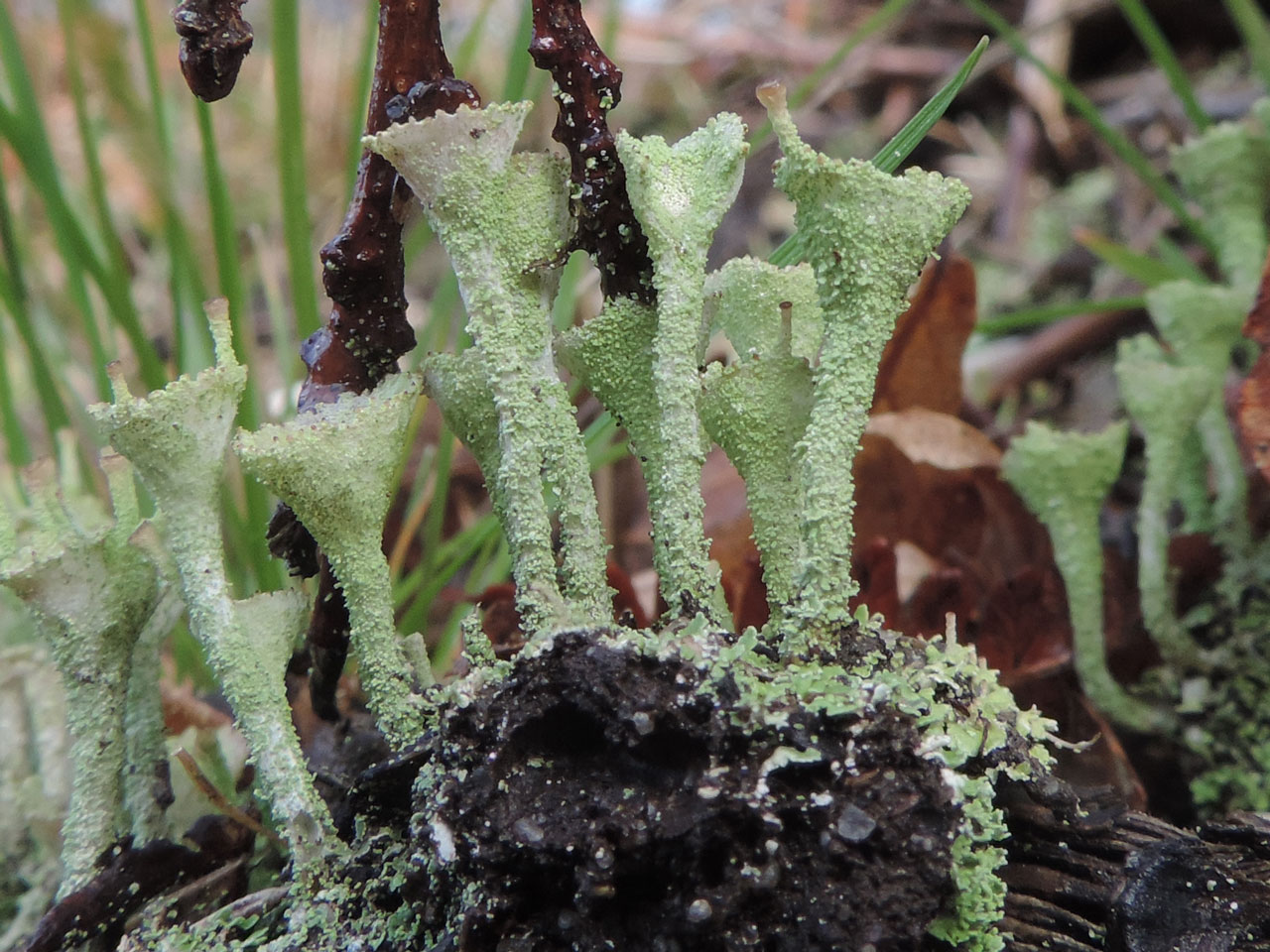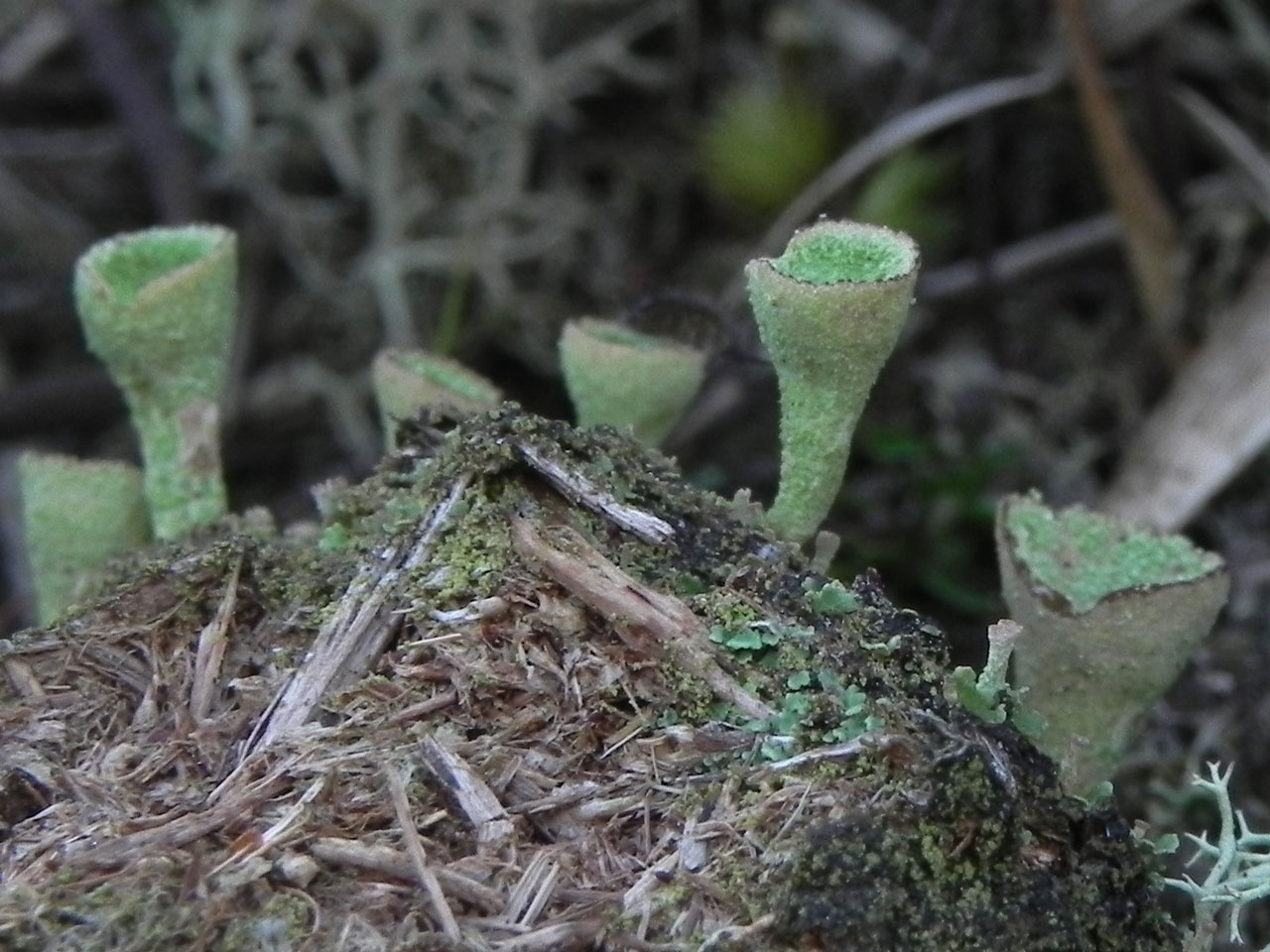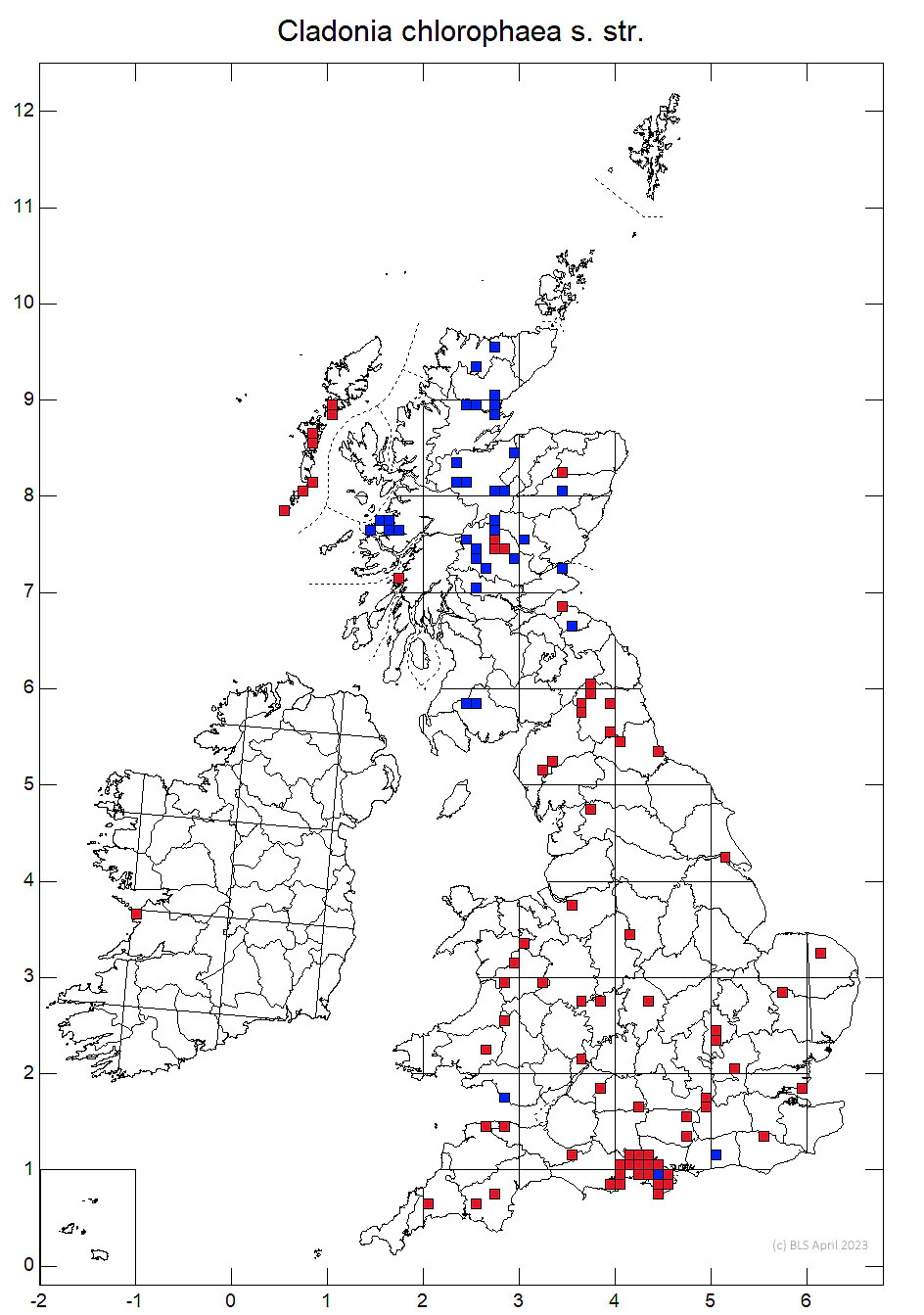A brown fruited Pyxie Cup in the difficult Cladonia chlorophaea complex. This group is characterised by sorediate podetia with goblet shaped cups, with brown apothecia or pycnidia. Cladonia chlorophaea s. str. is, however, not genetically closely related to the other taxa in the group, which are accommodated within Cladonia grayi s. lat. Cladonia chlorophaea s. str. is actually more closely related to Cladonia fimbriata and Cladonia pyxidata. Cladonia chlorophaea podetia are usually greenish with any exposed medulla being white and it lacks K+ or C+ spot tests or UV fluorescence. In contrast C. grayi s. lat. taxa are typically browner and have pink-brown tinged exposed medulla, and can have K+ or C+ spot tests or UV fluorescence, but TLC is required for definitive separation.
The more closely related species lack the granular soredia of Cladonia chlorophaea s. str., with Cladonia fimbriata entirely farinose-sorediate and with more abruptly tapering, golf tee shaped cups. C. pyxidata has gradually tapered cups almost to the base and covered with distinctly coarse, corticate granules, present even in juvenile material, and lacking any granular soredia at all.
Podetia 0.5–2.5 (–4) cm tall, greenish grey, sometimes slightly browned; scyphi 3–6 (–12) mm diam., gradually tapered to the stalk, sometimes ± regular but often proliferating (sometimes repeatedly) from the margins, patchily corticate below, becoming granular to ± sorediate above as well as within cups, the soredia often mixed with corticate granules and microsquamules. Basal squamules often small and inconspicuous, ± erect, sometimes incised. Apothecia and pycnidia brown, frequent; apothecia stalked or sessile on cup margins. Thallus C–, K–, KC–, Pd+ red, UV– (fumarprotocetraric acid).
Probably common throughout Britain and Ireland, but much confused formerly with other members of the Cladonia chlorophaea complex, especially the Cladonia grayi group. The latter have previously been included in a morphological assembly with C. chlorophaea (e.g. James 2009), and the complex (as C. chlorophaea s.lat. BLS 0371) is accepted as a pragmatic recording unit by some lichenologists. However, molecular data are incomplete, but C. chlorophaea occupies a different phylogenetic branch to the C. grayi aggregate.
Cladonia chlorophaea podetia are usually greenish with any exposed medulla being white and it lacks K+ or C+ spot tests or UV fluorescence. In contrast C. grayi s. lat. taxa are typically browner and have pink-brown tinged exposed medulla, and can have K+ or C+ spot tests or UV fluorescence, but TLC is required for definitive separation. Microcrystal tests (Orange 1992, Orange et al. 2010) are also powerful tools for identification in this group.
Cladonia chlorophaea and C. grayi s. lat. are also frequently confused with C. fimbriata, which has more abruptly tapering, goblet-shaped scyphi and is entirely farinose-sorediate. Also similar is C. pyxidata which has gradually tapered scyphi almost to the base and covered with distinctly coarse, corticate granules, present even in juvenile material and lacking any granular soredia.
Ahti & Stenroos (2013) observe that Cladonia chlorophaea tends to occupy somewhat less acidic habitats than C. grayi s. lat. These include less acid bark and lignum, decaying worked timber, acid grassland and loamy banks; it is largely replaced by C. grayi s. lat. in heathland and moorland on very acid humus and peat and on acid bark and lignum.

Probably widespread and frequent throughout Britain and Ireland, but much confused formerly with other members of the Cladonia chlorophaea complex. Much less frequent in very acid habitats than Cladonia grayi s. lat taxa, especially Cladonia cryptochlorophaea. The map contains only those records definitely identified as C. chlorophaea s. str.
Ahti, T. & Stenroos, S. (2013). Cladoniaceae. In: Ahti, T., Stenroos, S., & Moberg, R. (eds), Nordic Lichen Flora 5: 1–117.
James, P.W. (2009). Cladonia. In Lichens of Great Britain and Ireland (Smith, C.W., Aptroot, A., Coppins, B.J., Fletcher, A., Gilbert, O.L., James, P.W. & Wolselsey, P.A. eds): 309–338. London: British Lichen Society.
Orange, A. (1992). A key to the Cladonia chlorophaea group in Europe, using microcrystal tests. Bulletin of the British Lichen Society 70: 36–42.
Orange, A., James, P.W. & White, F.J. (2010). Microchemical Methods for the Identification of Lichens. 101 pp. London: British Lichen Society.
Pino-Bodas, R., Sanderson, N., Cannon, P., Aptroot, A., Coppins, B., Orange, A. & Simkin, J. (2021). Lecanorales: Cladoniaceae, including the genera Cladonia, Pilophorus and Pycnothelia. Revisions of British and Irish Lichens 19: 1-45. Link
Text by N A Sanderson, based Pino-Bodas et al (2021)


